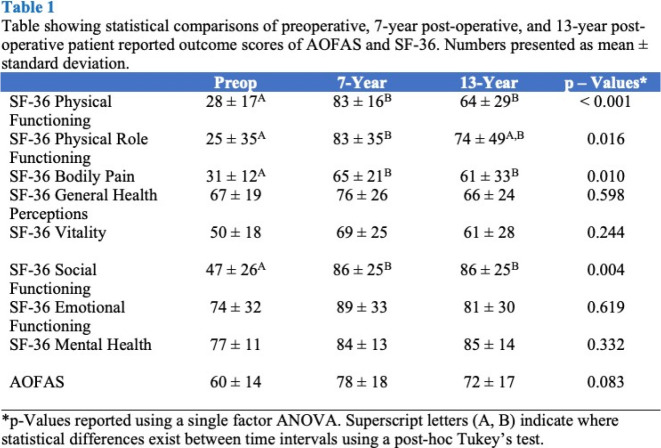Abstract
Category:
Ankle, Arthroscopy, Hindfoot, Sports, Trauma
Introduction/Purpose:
Surgical management of osteochondral lesions of the talus (OLT) present an ongoing treatment challenge. Previously, matrix-induced autologous chondrocyte implantation (MACI) demonstrated improved pain and function at 7-years postoperative, providing evidence that MACI is a reliable method for treating cartilage. However, it is unknown the long- term results of MACI in OLT. The purpose of this study was to assess 13-year clinical follow-up data and the long-term success of this implant by comparing patient reported outcome measures (PROMs) pre-operatively, at 7-years post-operative, and at 13- years post-operative.
Methods:
A prospective investigation of MACI was performed on 10 patients with OLTs who had failed previous arthroscopic treatment. Of the 10 patients, 9 were available for 7-year and 13-year follow-up. Short Form Health Survey (SF-36) and the American Orthopaedic Foot & Ankle Society (AOFAS) hindfoot evaluation were utilized at pre-operative, 7-year, a 13-year postoperative. For each patient, a paired t-test was used to compare 13-year post-operative PROMs to pre-operative PROMs. A single factor analysis of variance (ANOVA) determined whether PROMs were different between pre-operative, 7-year post- operative, and 13-year post-operative time intervals. When a significant difference was detected, a post-hoc Tukey’s determined which time periods were different.
Results:
SF-36 data at 13-years showed significant improvements in Physical Functioning (p=0.012), Lack of Bodily Pain (p=0.017), and Social Functioning (p=0.007) compared with preoperative data. There were no differences in other components of the SF-36 outcomes (p>0.05). Although the AOFAS was on average 12 points higher at 13-years postoperative, this was not statistically significant (p=0.173). As for comparing PROMs over time, 13-years post-operative PROMs were comparable to 7-years post- operative (Table 1). There were better PROMs for Physical Functioning, Bodily Pain, and Social Functioning at 7- and 13-years post-operative compared to pre-operative while Physical Role Functioning was also better at 7-years post-operative compared to pre-operative.
Conclusion:
This study shows MACI provides greater pain relief and function at 13-years post-operative with stable long-term follow-up. MACI should be considered for osteochondral lesions that fail initial microfracture.
Keywords: osteochondral lesion, talus, matrix-induced autologous chondrocyte implantation



